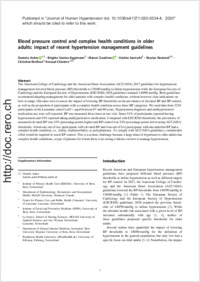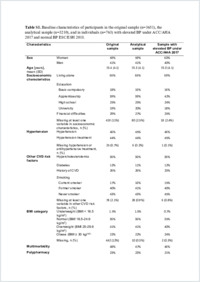Blood pressure control and complex health conditions in older adults: impact of recent hypertension management guidelines
- Anker, Daniela Institute of Primary Health Care (BIHAM), University of Bern, Bern, Switzerland - Department of Epidemiology, Biostatistics and Occupational Health, McGill University, Montreal, Canada
- Santos-Eggimann, Brigitte Center for Primary Care and Public Health (Unisanté), University of Lausanne, Lausanne, Switzerland
- Zwahlen, Marcel Institute of Social and Preventive Medicine (ISPM), University of Bern, Bern, Switzerland
- Santschi, Valérie La Source, School of Nursing Sciences, HES-SO University of Applied Sciences and Arts Western Switzerland, Lausanne, Switzerland
- Rodondi, Nicolas Institute of Primary Health Care (BIHAM), University of Bern, Bern, Switzerland - Department of General Internal Medicine, Inselspital, Bern University Hospital, University of Bern, Bern, Switzerland
- Wolfson, Christina Department of Epidemiology, Biostatistics and Occupational Health, McGill University, Montreal, Canada
- Chiolero, Arnaud Institute of Primary Health Care (BIHAM), University of Bern, Bern, Switzerland - Department of Epidemiology, Biostatistics and Occupational Health, McGill University, Montreal, Canada - Population Health Laboratory (#PopHealthLab), University of Fribourg, Fribourg, Switzerland
-
28.04.2020
Published in:
- Journal of Human Hypertension. - 2021, vol. 35, no. 3, p. 280-289
English
The American College of Cardiology and the American Heart Association (ACC/AHA) 2017 guidelines for hypertension management lowered blood pressure (BP) thresholds to 130/80 mmHg to define hypertension while the European Society of Cardiology and the European Society of Hypertension (ESC/ESH) 2018 guidelines retained 140/90 mmHg. Both guidelines recommend adapting management for older patients with complex health conditions, without however clear indications on how to adapt. Our aims were to assess the impact of lowering BP thresholds on the prevalence of elevated BP and BP control, as well as the proportion of participants with a complex health condition across these BP categories. We used data from 3210 participants in the Lausanne cohort Lc65+ aged between 67 and 80 years. Hypertension diagnosis and antihypertensive medication use were self-reported. BP was measured three times at one visit. Some 51% of participants reported having hypertension and 44% reported taking antihypertensive medication. Compared with ESC/ESH thresholds, the prevalence of measured elevated BP was 24% percentage points higher and BP control was 24% percentage points lower using ACC/AHA thresholds. About one out of two participants with elevated BP and four out of five participants with uncontrolled BP had a complex health condition, i.e., frailty, multimorbidity, or polypharmacy. To comply with ACC/AHA guidelines, considerable effort would be required to reach BP control. This is a serious challenge because a large share of hypertensive older adults has complex health conditions, a type of patients for whom there is no strong evidence on how to manage hypertension.
- Faculty
- Faculté des sciences et de médecine
- Department
- Master en médecine
- Language
-
- English
- Classification
- Medicine
- License
- License undefined
- Identifiers
-
- RERO DOC 329926
- DOI 10.1038/s41371-020-0334-4
- Persistent URL
- https://folia.unifr.ch/unifr/documents/309340
Other files
Statistics
Document views: 104
File downloads:
- chi_bpc.pdf: 194
- chi_bpc_sm.pdf: 93

